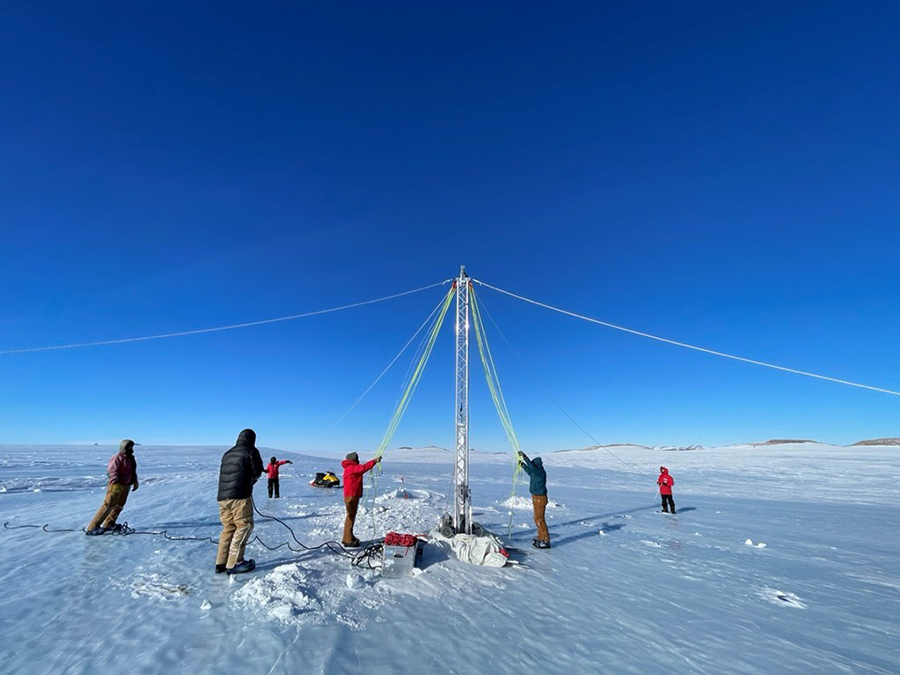Hunt begins for Antarctica's oldest iceGlaciologists aim to extend Earth's climate record further into the past than ever beforePosted December 19, 2022
U.S. researchers on the southernmost continent are in the midst of their first field season of a multi-year project to find and extract the oldest ice in Antarctica. The Center for Oldest Ice Exploration, or COLDEX, is a large NSF Science and Technology Center project that aims to drill ice cores containing the oldest possible glacier ice from the massive East Antarctic Ice Sheet. Researchers hope to collect at least one ice core that will give them a continuous record of Earth's climate history going back one million years or more. This type of ice core record could allow scientists to answer fundamental questions about Earth's climate history, including how sensitive ice sheets are to higher levels of greenhouse gases in the atmosphere and how Antarctica's ice sheets might respond to warmer climates. 
Photo Credit: Peter Neff.
The Allan Hills ice coring team setting up the drill tower of the Blue Ice Drill in December 2022.
COLDEX researchers are deploying with the U.S. Antarctic Program this austral summer season to scout some initial locations where they suspect old ice might be. Antarctica's ice constantly flows toward the ocean (like a frozen river), so although much of the continent has been covered in ice for millions of years, most of the oldest ice has been sloughed off to sea. To find those few locations where old ice has been preserved, researchers are surveying large swaths of the East Antarctic Ice Sheet (which covers an area roughly the size of the continental United States) for places that are thick enough, cold enough, and sufficiently undisturbed by the rock underneath to have preserved ice in sequential layers for millions of years. “All of these different types of scientific teams need to work together… to find essentially a needle in a haystack,” said Peter Neff, a glaciologist at the University of Minnesota who is part of the COLDEX team deploying this season and is COLDEX's Director for Field Research and Data. “We're looking for that perfect location where you're going to have a full sequence of ice that's on the order of two miles thick.” Extending the climate recordScientists get a record of Earth's climate by analyzing air bubbles trapped in glacier ice. Bubbles of air get trapped in snow as it compresses to form a glacier, so analyzing those bubbles tells scientists what the atmosphere was like at the time those bubbles formed – including how much carbon dioxide was present in the air. The longest continuous ice core record scientists have now comes from an ice core drilled in East Antarctica 20 years ago. That core shows changes in climate and atmospheric carbon dioxide levels over the past 800,000 years. COLDEX researchers hope to obtain a continuous record of Earth's climate going back more than a million years to learn more about warmer climates like those the Earth may experience in the near future. “The goal is to extend the ice core record of climate change back at as far as we can,” said Edward Brook, a climate researcher at Oregon State University and director of the COLDEX project. “It would even be remarkably important if we could push it back to three or four million years or even older.” Finding the needle in the haystackDuring the first phase of the COLDEX project, which will last five years, researchers will be focusing on two areas of Antarctica where they suspect the continent's oldest ice has survived. The first location will be on the East Antarctic Plateau, a region encompassing the geographic South Pole where the ice is nearly two miles thick. This austral summer season, scientists are conducting aerial radar surveys of a region roughly the size of Washington state to identify potential sites for ground-based ice exploration. Researchers hope to drill a deep ice core from this region during a later phase of the COLDEX project. The second location will be the western margin of the East Antarctic Ice Sheet in an area called Allan Hills. At Allan Hills, the Transantarctic Mountains act as a wedge, forcing ice upward as it flows toward the sea and bringing old ice close to the surface where it's easier to extract. During this austral summer season, scientists are conducting radar and GPS surveys at Allan Hills to find sites that might preserve ice that is more than two million years old. Researchers don't expect to drill a long ice core at Allan Hills, but instead hope to extract samples of very old ice and shorter cores that can complement a long ice core drilled from the East Antarctic Plateau. “This ice is not continuous in the sense you can't start at three million at Allan Hills and take samples all the way to today,” Brook said. “So we're going to trying to build up as many snapshots as we can and then reconstruct the history of climate from that.” Brook and Neff liken it to trying to figure out your family history from a series of photographs. If COLDEX scientists can eventually recover a long ice core from the East Antarctica Plateau, that would be like having a full movie of your family history rather than just snapshots. This research is supported by the National Science Foundation, which manages the U.S. Antarctic Program. NSF-funded research in this story: Edward Brook, Oregon State University, award 2019719 |
"News about the USAP, the Ice, and the People"



For USAP Participants |
For The Public |
For Researchers and EducatorsContact UsU.S. National Science FoundationOffice of Polar Programs Geosciences Directorate 2415 Eisenhower Avenue, Suite W7100 Alexandria, VA 22314 Sign up for the NSF Office of Polar Programs newsletter and events. Feedback Form |


